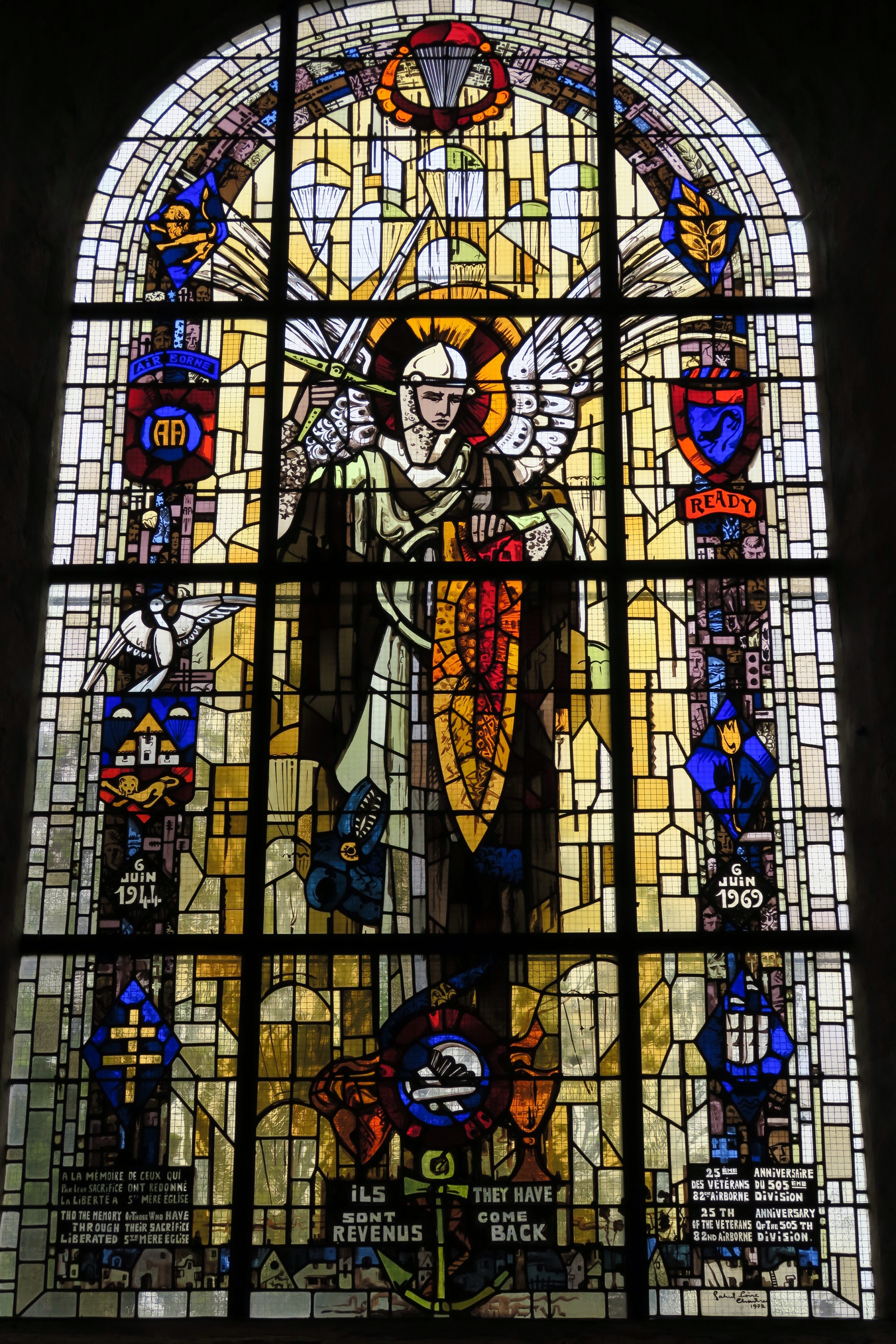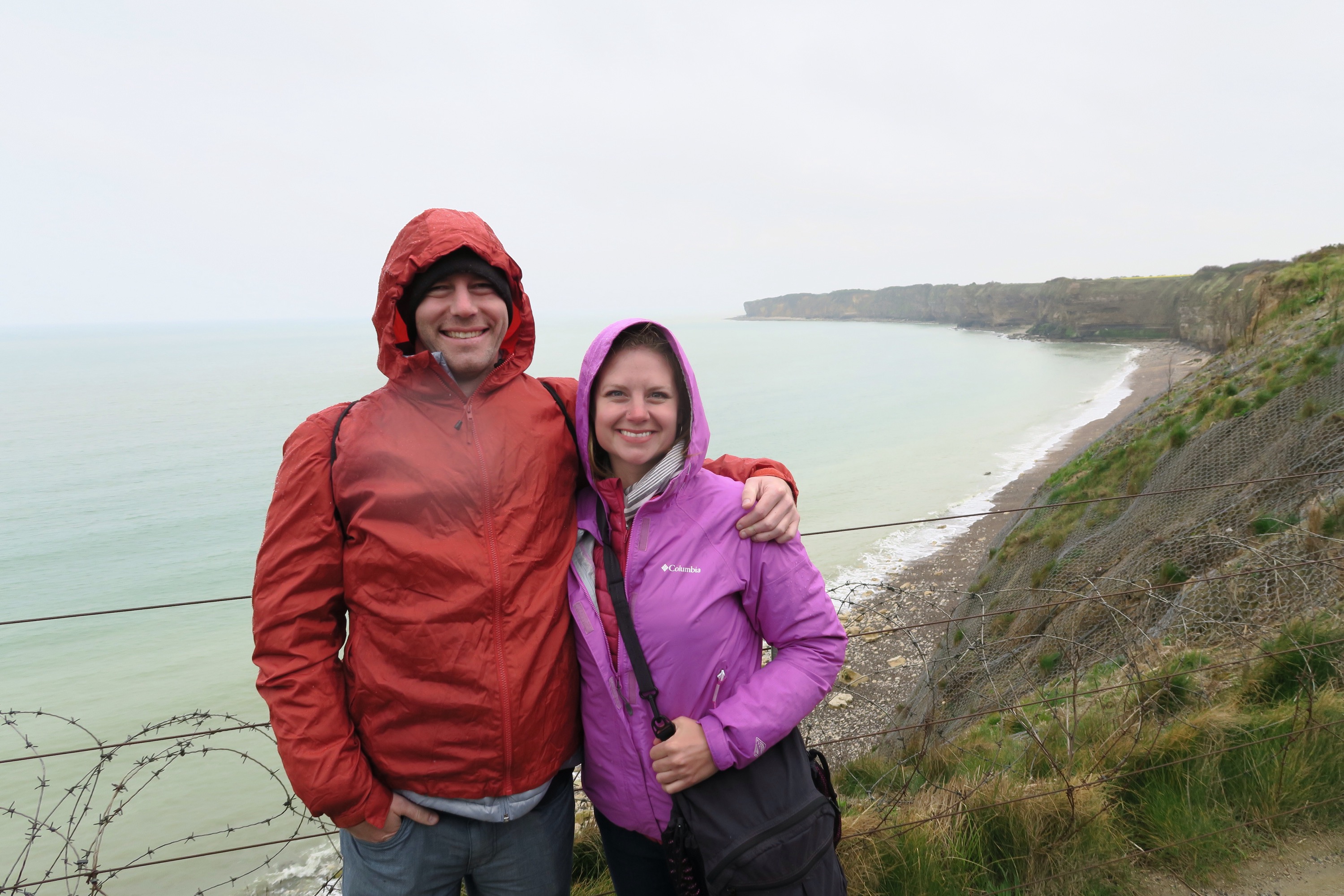This past weekend Mac and I spent a couple of days exploring Normany. Learning more about World War II—and seeing the battlefields—had been on my bucket list for a long time. After all, learning about history is one of the best ways to make sure it doesn’t repeat itself. On Friday, we spent a full day at the Museum Memorial in Caen, exploring all of the events that led up to World War II. Then on Saturday we spent a full day on a minibus touring the most important sites we’d learned about, including Saint-Mère-Église, Utah Beach, Omaha Beach, and the American Cemetery.
You might remember Saint-Mère-Église from the movie The Longest Day and the famous story of an American soldier who got caught on the roof of the cathedral while parachuting down on D-Day. There’s now a permanent memorial to mark the spot where it happened.
 Inside the church there are beautiful stained glass windows commemorating the parachuters who helped liberate the city. The movie, filmed in Saint-Mère-Église in 1969, also gets a stained-glass mention.
Inside the church there are beautiful stained glass windows commemorating the parachuters who helped liberate the city. The movie, filmed in Saint-Mère-Église in 1969, also gets a stained-glass mention.
 One of my favorite spots we visited was Pointe du Hoc, which is located between Utah Beach and Omaha Beach (and has the most surviving evidence of World War II). From there, the Germans could fire on both beaches at once. On D-Day, more than 60% of the Army Rangers who landed at—and climbed—the impressive cliffs were either killed or severly injured as they fought the Germans and waited for reinforcements. It took two days for reinforcements to arrive, but eventually the enemy encampments at Pointe du Hoc were fully neutralized—one of the keys to the success of the Battle of Normany.
One of my favorite spots we visited was Pointe du Hoc, which is located between Utah Beach and Omaha Beach (and has the most surviving evidence of World War II). From there, the Germans could fire on both beaches at once. On D-Day, more than 60% of the Army Rangers who landed at—and climbed—the impressive cliffs were either killed or severly injured as they fought the Germans and waited for reinforcements. It took two days for reinforcements to arrive, but eventually the enemy encampments at Pointe du Hoc were fully neutralized—one of the keys to the success of the Battle of Normany.

True to the day of the invasion, it rained on us at Normany. Thank goodness we packed our rain coats.
 There were all sorts of little windows and corners in the German bunkers. Even though Pointe du Hoc was a sobering place to be, we really enjoyed exploring the different buildings.
There were all sorts of little windows and corners in the German bunkers. Even though Pointe du Hoc was a sobering place to be, we really enjoyed exploring the different buildings.
 As if the D-Day beaches weren’t thought-provoking enough, we also visited the American Cemetery, where thousands of Americans who lost their lives in World War II are buried. Some of them—like this one—are still unidentified.
As if the D-Day beaches weren’t thought-provoking enough, we also visited the American Cemetery, where thousands of Americans who lost their lives in World War II are buried. Some of them—like this one—are still unidentified.

I’ll leave you with a quote that I saw in the Museum Memorial in Caen. It struck me as symbolic of what was left behind immediately after the Battle of Normandy, with its death, destruction, and ultimate victory. It’s a far cry from what you see there today.
“From either side of the road, and here and there in the wheat fields, there were glimpses of overturned cars, burnt-out lories, disembowelled tanks and abandonded cannons, all of them contorted by explosions. But not a single man, nothing living. Not even a corpse, not even the carcass of a horse. There was nothing but dead iron for miles and miles around. Carcasses of machines, hundreds upon hundreds of sorry steel carcasses. The stink of rotting iron rose from the fields and lagoons. In the middle of a pond, an aeroplane cabin emerged from the sludge. The swastika was clearly visible: it was a Messerschmitt.” – Curzio Malaparte



Mac- I am one of your mom’s ya-ya sisters (sorority). I am enjoying your travels. Can you imagine that you are more than 10 years older than those that died on D-Day?
Sounds like a wonderful adventure so far.